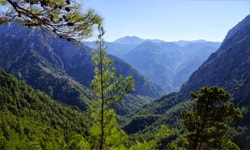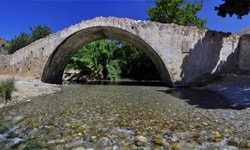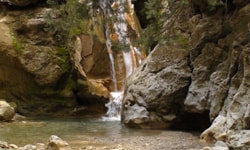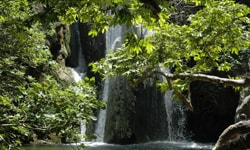Approximately two kilometers northwest of the village Karines at position Faragi there is a small but impressive gorge, Kariniotiko Gorge. Kariniotiko canyon is completely unknown as the entire surrounding area is not included in the tourist routes. However, the surrounding area has exceptional natural beauty and hosts one of the most impressive oak wood of Crete with huge ancient trees.
A very wild gorge starting from the valley of Pervola, next to Mournia village at Asterousia Mounts, and ending on the remote amazing beach of Kaminaki. There is a trail, quite steep, starting from Pervola.
Its exit is located in the village Nomikiana, Sfakia province. In Chionistra there are two different streams in calcareous soils which after one hour walking each merge to form the gorge of Kapni. The canyon is quite long and walking in it takes about 4 hours. It is one of the difficult and dangerous gorges of Crete with craggy riverbed which in some places creates dry waterfalls and requires climbing.
The gorge of Valahas is formed south of Heraklion and the beach Elygia is formed at its exit. The highest rapel is 50m high and 4 hours are required for its crossing (only with canyoning equipment). The lower part of the gorge is covered by pine trees.
The Gorge of Katsouna, near Vrysses, is believed to be the Xenia Street of Herodotus, according to who the guests of ancient Pergamos arrived through here in order to not have visual contact with the forts of the town. The length of the gorge is about one kilometer and starts from Vrysses to reach the entrance of the ancient city.
Kollita Gorges, i.e. Twin Ravines are located nearby the picturesque village Argyroupolis, about 22km southwest of Rethymnon city. They are named so, as they consist of two parallel canyons that end near Kato Poros settlement. Here we refer to the easternmost gorge of Moundros.
Vavouledo canyon starts about 1km east of the village Hamalevri. A trail runs along the gorge. Near the village Lidiana, the canyon joins the Gorge of Trahinos and the merged river runs till the "cosmopolitan" neighborhood of the Palea Roumata, Arhontika, where you can eat at the taverns.
The lush canyon of Vederi starts from the village Fratzeskiana Metohia, passes next to the village Vederi and ends on the beach of Gerani (after 7km). The canyon has dense vegetation that makes trekking very difficult, as there is no footpath along its length.


























































































